
As with many of the menus, there are more options than can be shown on one screen. Try selecting
Screenshots may vary.
NOTE: Some newer vehicles may have a heat reflective shield embedded in the windshield. In some cases this can prevent proper GPS signal reception. If this turns out to be a problem in your vehicle, try mounting your GPS receiver behind your rear view mirror or rear shelf.
Tip: In order to use in-car chargers, you may need to set your ignition key in an 'Accessories' position. Please consult your vehicle handbook.
Before you can use TomTom NAVIGATOR 5 you must install the application and a map from the CD set. Please refer to the installation poster for more information.
Some TomTom maps need to be activated before they can be used. You can activate maps automatically using GPRS, or manually on a PC via our website. To activate your map you will need a product code, found on the product code card included with your purchase.
Note: For automatic activation, you need a GPRS-ready mobile phone with Bluetooth. If you already pick up email or browse the Internet on your phone, then it's probably already GPRS-ready; if you're not sure, ask your network provider.
To activate your map via GPRS, select the 'Automatic' button and follow these instructions:
To activate your map using your PC, select the 'Manual' button and follow these instructions:
Once the map has been activated, you can continue through the rest of the start up process.
The application starts by displaying the navigation view. The screen will appear in black and white until your GPS receiver locates your current position. Once this is done, the navigation view is shown in full color. In future, your position will be found much faster, normally within a few seconds. Everything can be accomplished easily using just your finger. Importantly, you can bring up the main options menu by tapping your finger somewhere in the middle of the screen or pressing the joystick.
NOTE: TomTom GPS receivers connect automatically when you start the application. If you are using a different GPS unit, refer to the device manual for connection instructions.

As with many of the menus, there are more options
than can be shown on one screen. Try selecting
![]() a few times, to cycle through all the different things you can do.
a few times, to cycle through all the different things you can do.
1. Move outside, if you haven't already done so, so that the GPS hardware can locate your position. This may take some time, and will happen more quickly if you remain still. The screen displays your current position on its map, represented in a '3D' navigation view, from a driver's perspective. When you start moving, the navigation view will match the streets outside as you would see them through your windshield.

Your position (and direction) is indicated by the
![]() icon.
icon.
2. Bring up the main
menu. Use
![]() a few times to browse through all the different things you can do, then choose
'Navigate to...'
a few times to browse through all the different things you can do, then choose
'Navigate to...'
![]() to start planning
your first route.
to start planning
your first route.
Tip: Don't worry if some of the icons are 'greyed out', this just indicates that these menu options aren't available yet. E.g. as you haven't yet planned a route then 'Find alternative...', 'View route' and 'Clear route' are all greyed out.

Remember that
![]() always means that there's more to see on the next page, in this case extra ways
of choosing a destination.
always means that there's more to see on the next page, in this case extra ways
of choosing a destination.
3. Choose
'Address' ![]() .
You'll see a standard browser screen, used for entering place names (e.g. towns,
streets and favorite locations). Letters can be entered using the on-screen keyboard or device keypad.
.
You'll see a standard browser screen, used for entering place names (e.g. towns,
streets and favorite locations). Letters can be entered using the on-screen keyboard or device keypad.
4. The best way to see how your TomTom system works is to use it for real, so think of the address that you want to visit and enter the first few letters of the city, town or village. Be as specific as possible. As you type, the letters are compared to the built-in list of possible names and any matches appear in the browser window.

Quick-matching a town name. Use
![]() and
and
![]() or the joystick to scroll
through other possible matches. If you make a mistake, use
or the joystick to scroll
through other possible matches. If you make a mistake, use
![]() or the 'Clear' key to delete the last letter entered.
or the 'Clear' key to delete the last letter entered.
5. When you see the name of the place you want, select it using the touchscreen or joystick. A new browser window is now shown, this time with the prompt 'Street:' at the top. Again, start entering the road name of your destination, selecting it when the full name is shown among the matches. In cases where there is more than one road of the same name, additional information is displayed to help you choose the correct location.
6. A third and final keyboard and browser are shown, this time for you to select a house number. For some roads (such as those that don't have house numbers), you'll be asked to select a particular 'Crossing:' (i.e. an intersection). Select a crossing, or enter the house number and then choose 'Done'.
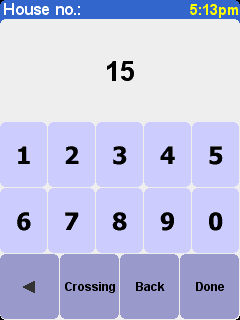
If
you'd rather pick a crossing than a house number, just select the 'Crossing'
button or press the joystick.
7. The fastest route from your current position to your destination is then calculated. This should only take a few seconds and its progress is shown on the screen. When done, a summary is shown, on a suitably scaled map. Studying this summary can be useful for you to get a feel for your journey’s scope and to check if the route includes roads that you’d rather avoid (in which case, see ‘Find alternative...’, below).
8. Select 'Done' and you'll find yourself back at the main navigation view, but with the route now clearly colored in for you. As you approach a specific turn in the calculated route, your chosen voice will tell you what to do. For example, "In 100 yards, turn left", followed by "Turn left". As you travel, following the voice instructions, you'll notice that the navigation view is updated constantly, always showing coming roads and junctions and presenting the best route to you.
Don't worry if you miss a turn or drive down the wrong road. A new fastest route will be calculated automatically, based on your new position and direction of travel. Wherever you go, it will always give you instructions that will take you to your chosen destination.
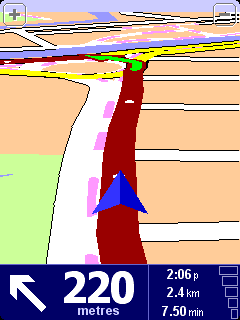
White arrow heads show the direction you need to move along the
current road and a specially-shaped green arrow shows what to do at the next
turn or intersection.
The planning's all done, now just buckle your seat belt and drive. As you approach a specific turn in the calculated route, your chosen voice will tell you what to do. For example, "In 100 yards, turn left", followed by "Turn left", without you having to take your eyes off the road. As you travel, following the voice instructions, you'll notice that the navigation view is updated constantly, always showing coming roads and junctions and presenting the best route to you.
Don't worry if you miss a turn or drive down the wrong road. A new fastest route will be calculated automatically, based on your new position and direction of travel. Wherever you go, it will always give you instructions that will take you to your chosen destination.
Much of the information on the main navigation view is configurable (see the 'Preferences' chapter for details). By default, you'll see something like the illustration below.
 |
|
If you miss a voice instruction, tap on the turn instruction in the
bottom left hand corner (![]() ) to generate a new one. And if you'd like to view the
route summary again, tap anywhere in the journey information panel in the
bottom right hand corner (
) to generate a new one. And if you'd like to view the
route summary again, tap anywhere in the journey information panel in the
bottom right hand corner (![]() or
or
![]() ).
).
Most of the time, the voice and turn instructions are all you need to navigate successfully, which means never having to take your eyes off the road. At complicated junctions, where simple instructions aren't adequate to describe the path to take, the navigation view comes into its own. A quick comparison between the screen and the world in front of you should be all you need.
Tip: No instruction is shown or spoken at junctions that require no action. In towns and cities especially, don't be concerned that you are passing side-roads and driving through intersections without any instruction.
This is the simplest and most useful starting point in most situations.
Given your current GPS position, you can use this to navigate to any given
address, crossing, favorite location, Point Of interest, and so on. Select
'Navigate to...'
![]() to bring up its
first options screen.
to bring up its
first options screen.
'Recent destination'
![]() is a
useful time-saver, displaying a list of addresses, Points Of Interest and other
destinations that you've used before.
is a
useful time-saver, displaying a list of addresses, Points Of Interest and other
destinations that you've used before.
'Address'
![]() displays the same
city/street grids that you used in 'Planning your first
route', so just choose your destination in the usual way. If
you're not sure of the exact street name to type in, note that simply entering
the city's name again (or using the 'City center'
displays the same
city/street grids that you used in 'Planning your first
route', so just choose your destination in the usual way. If
you're not sure of the exact street name to type in, note that simply entering
the city's name again (or using the 'City center'
![]() option,
described below) will get you to the geographical center of the city.
option,
described below) will get you to the geographical center of the city.
Choosing 'Home'
![]() here is quick and
obvious, though if you chose not to set a home location when setting up your
TomTom system then this may still be greyed out. For more on setting up a home
location, see 'Home preferences'.
here is quick and
obvious, though if you chose not to set a home location when setting up your
TomTom system then this may still be greyed out. For more on setting up a home
location, see 'Home preferences'.
Although you're going to be navigating to many places you don't know
well, there will also be a number of locations that you visit frequently and
that you want to be able to travel from (and to) without having to enter their
address details each time. These are your 'Favorites'. See 'Favorite locations' for more on setting these up. Use
'Favorite'
![]() to navigate to
such a location.
to navigate to
such a location.
Note: 'Favorite' will be greyed out and unavailable if you haven't set any favorites yet.
'Point of interest'
![]() is your way into
the huge database of railway stations, restaurants, gas stations, and so on. Choosing this will display icons for the five categories
that you use most often. If the one you want now isn't shown here then use
is your way into
the huge database of railway stations, restaurants, gas stations, and so on. Choosing this will display icons for the five categories
that you use most often. If the one you want now isn't shown here then use
![]() to bring up a browser with all categories that are available.
to bring up a browser with all categories that are available.
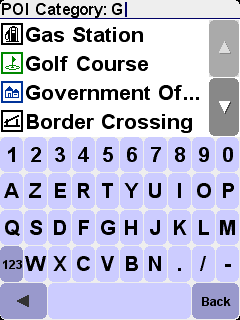
Use
![]() and
and
![]() to scroll through the list or enter a few letters of the required
category's name. When you see the category you want, select it, to bring up a
list of all Points Of Interest in that category, sorted according to
their distance from your current position. Use
to scroll through the list or enter a few letters of the required
category's name. When you see the category you want, select it, to bring up a
list of all Points Of Interest in that category, sorted according to
their distance from your current position. Use
![]() and
and
![]() to scroll through the list or, if you know the name of the Point Of
Interest you want, choose the keyboard icon
to scroll through the list or, if you know the name of the Point Of
Interest you want, choose the keyboard icon
![]() and then
enter a few starting letters.
and then
enter a few starting letters.
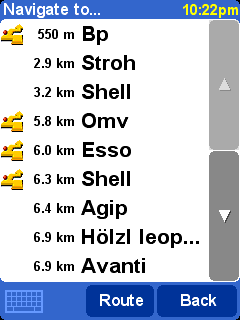
There are several icons used beside Points Of Interest in the
list. A straight green arrow means that the POI is on your route; a bent green
arrow means that a small detour from your route is needed to reach it; a bent
yellow arrow means that this POI needs a bigger detour from your route;
finally, with no icon shown, the POI is not on your route at
all.
Finally, select any Point Of interest to make it your destination.
Tip: Some of the more specialized Point Of Interest categories (e.g. 'Place of worship', 'Theater') may contain information only for major cities.
By selecting
![]() in the 'Navigate to...' menu, you can view even more navigation options.
Choose 'ZIP code'
in the 'Navigate to...' menu, you can view even more navigation options.
Choose 'ZIP code'
![]() if you know this
information for your destination and would prefer to enter this than use the
town or city name. Once you've selected a ZIP code in the browser, you'll be
asked to choose a street name (if needed) and house number in the usual
way.
if you know this
information for your destination and would prefer to enter this than use the
town or city name. Once you've selected a ZIP code in the browser, you'll be
asked to choose a street name (if needed) and house number in the usual
way.
Tip: You can change your mind and start entering the town name after all. Or indeed start entering a ZIP code in the main Address browser. It really is up to you. Note that full ZIP code support is only available for the UK and the Netherlands.
If you're good with maps and you'd prefer to pick a destination by eye,
or if you're simply not sure of a valid street name or ZIP code to enter,
choose 'Point on map'
![]() . You can then
scroll around the map, zooming in or out as needed. Finally, select a point on
the map as your destination and use 'Done'. For more information on using the
TomTom map browser, see the chapter on 'Maps'.
. You can then
scroll around the map, zooming in or out as needed. Finally, select a point on
the map as your destination and use 'Done'. For more information on using the
TomTom map browser, see the chapter on 'Maps'.

On TomTom GO or TomTom NAVIGATOR, you can 'drag' the map to
scroll it in any direction or drag the zoom control up or down to zoom out or
in. TomTom MOBILE users should use their D-pad and Enter keys.
When traveling into an unfamiliar city, you might not know a
destination road name, of course. Choose 'City center'
![]() to
automatically navigate to the geographical center of any city name entered in
the usual way.
to
automatically navigate to the geographical center of any city name entered in
the usual way.
In a similar way, choose 'POI in city'
![]() to navigate to
a Point Of interest in an unfamiliar city (e.g. a Hotel or Parking Garage).
Choose a city name in the usual way and then a Point of interest category. The
possible POIs are automatically sorted by proximity to the center of the chosen
city.
to navigate to
a Point Of interest in an unfamiliar city (e.g. a Hotel or Parking Garage).
Choose a city name in the usual way and then a Point of interest category. The
possible POIs are automatically sorted by proximity to the center of the chosen
city.
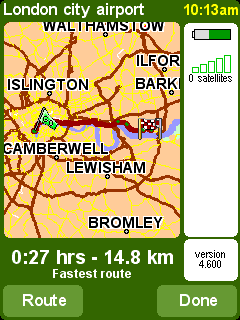
Once planned, a summary of the
calculated route is shown on a suitably scaled map. Select 'Route' to explore
the route in various ways. See 'Advanced route planning'
for more details.
'Favorites' are locations that you visit frequently and that you want
to be able to travel from (and to) without having to enter their address
details each time. Select 'Add favorite'
![]() to bring up its
first options screen.
to bring up its
first options screen.
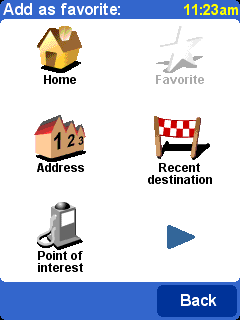
You'll notice that the 'Add favorite' choices are very similar
to those for 'Navigate to', in the last chapter.
Whichever option you use, once the location has been chosen, you'll get the
chance to enter a name for the favorite (e.g. "Steve's house", "Office",
"Uncle Fred")
Tip: When naming a favorite, the letters you enter automatically replace the highlighted suggestion. If you just wish to add a letter or two to the supplied suggestion, first either tap on the highlighted words (TomTom GO and NAVIGATOR users) or use NAVIGATOR right (TomTom MOBILE users).
Choose 'Home'
![]() to add your 'home'
location to your favorites list, for extra convenience. If this option is
greyed out, it means that you haven't chosen a 'home' location yet. See 'Home preferences' for more details.
to add your 'home'
location to your favorites list, for extra convenience. If this option is
greyed out, it means that you haven't chosen a 'home' location yet. See 'Home preferences' for more details.
Choose 'Address'
![]() to add a specific
address as a favorite.
to add a specific
address as a favorite.
Choose 'Recent destination'
![]() to add
a favorite from a list of addresses, Points Of Interest and other destinations
that you've used before.
to add
a favorite from a list of addresses, Points Of Interest and other destinations
that you've used before.
Choose 'Point of interest'
![]() to select a POI
from the built-in databases as a favorite. As with navigating to a POI, you'll
first see the five categories that you use most often, if the one you want
isn't shown then use
to select a POI
from the built-in databases as a favorite. As with navigating to a POI, you'll
first see the five categories that you use most often, if the one you want
isn't shown then use
![]() to bring up a browser showing the full list. Within each category, you'll see a
list of all POIs, neatly sorted according to their distance from your current
position. Simply pick the one you want to make a favorite.
to bring up a browser showing the full list. Within each category, you'll see a
list of all POIs, neatly sorted according to their distance from your current
position. Simply pick the one you want to make a favorite.
By selecting
![]() , you can view more options for picking a location as a favorite.
Choose from 'Zip code'
, you can view more options for picking a location as a favorite.
Choose from 'Zip code'
![]() , 'Point on
map'
, 'Point on
map' ![]() , 'City
center'
, 'City
center' ![]() or
'POI in city'
or
'POI in city'
![]() , in exactly the
same way as you would for setting each as a destination in the previous
chapter.
, in exactly the
same way as you would for setting each as a destination in the previous
chapter.
Choosing 'GPS position'
![]() is very
useful when you want to store your current location quickly. For example, you
are passing something interesting and want to return there later. Since you
don't need to bother finding the location by address, it is also one of the
fastest ways of adding a favorite, so consider using this whenever you visit
somewhere that you know you'll want to return to at a later date.
is very
useful when you want to store your current location quickly. For example, you
are passing something interesting and want to return there later. Since you
don't need to bother finding the location by address, it is also one of the
fastest ways of adding a favorite, so consider using this whenever you visit
somewhere that you know you'll want to return to at a later date.
Tip: You don't have to travel, physically, to a location in order to set it as a favorite! Instead, see the 'Cursor functions' in 'Browse map'.
Once a favorite has been chosen and named, it will show up whenever you
pick from your list of favorites, for example in 'Navigate to...'
![]() 'Favorite'
'Favorite'
![]() .
.
Maybe a route has been planned that you're not happy with? Perhaps you
have been routed via a busy area? Have you spotted roadwork up ahead? Or
perhaps you really wanted to go 'via' one particular location? This is where
the 'Find alternative...'
![]() option comes in.
option comes in.
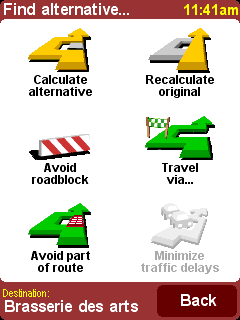
Choose 'Travel via...'
![]() if you want to
make sure the planned route goes past one particular location, perhaps to
pick up or drop someone off. The new location is picked in exactly
the same way as you would pick a departure point or destination, with the usual
options of 'Home', 'Favorite', 'Address', 'Point Of interest', and so on. Once
selected, a new fastest route is calculated, making sure to include your 'via'
location.
if you want to
make sure the planned route goes past one particular location, perhaps to
pick up or drop someone off. The new location is picked in exactly
the same way as you would pick a departure point or destination, with the usual
options of 'Home', 'Favorite', 'Address', 'Point Of interest', and so on. Once
selected, a new fastest route is calculated, making sure to include your 'via'
location.
Tip: If you want to include more than a single 'via' location in your journey, use the comprehensive Itinerary feature instead, described later in this chapter.
If you spot signs of trouble (such as backed-up traffic or 'Delays
ahead' warning signs), choose 'Avoid roadblock'
![]() . To save
you time (when you're on the road), there are four presets. Estimate whether
the blockage extends '100yds', '500yds', '2000yds' or
'5000m' ahead from your current position and then select the appropriate
icon.
. To save
you time (when you're on the road), there are four presets. Estimate whether
the blockage extends '100yds', '500yds', '2000yds' or
'5000m' ahead from your current position and then select the appropriate
icon.

Once you've chosen a roadblock option, a new
route is quickly calculated that avoids all roads for the chosen distance along
the planned route, routing you right round the troubled area.
Tip: After choosing a roadblock option, look out for a turn direction on the screen almost immediately. If you continue into the 'blocked' area, you may want to use 'Find alternative...' and then 'Avoid roadblock' again, to recalculate your best route taking into account your new position.
If you want to avoid a particular intersection, perhaps because it's a
known traffic black spot, choose 'Avoid part of route'
![]() . Use
. Use
![]() and
and
![]() to scroll through the current route instructions, choosing which
junction you want to steer clear of. A new route will then be calculated.
to scroll through the current route instructions, choosing which
junction you want to steer clear of. A new route will then be calculated.
Note: Any junctions that have already been passed are greyed out and can't be selected.
Finally, if you want an alternative route because you simply don't like
the original, choose 'Calculate alternative'
![]() . As far as
possible, a totally different set of roads is used. Once planned, an overview
is shown, as usual, and you can choose 'Route' for detailed instructions
or 'Done' to switch back to the main navigation view. You can keep
asking for (increasingly inefficient) alternative routes using this method
until the message 'No route found' appears. Choose 'Recalculate
original'
. As far as
possible, a totally different set of roads is used. Once planned, an overview
is shown, as usual, and you can choose 'Route' for detailed instructions
or 'Done' to switch back to the main navigation view. You can keep
asking for (increasingly inefficient) alternative routes using this method
until the message 'No route found' appears. Choose 'Recalculate
original' ![]() to
return to the original best route.
to
return to the original best route.
If you have enabled TomTom Traffic and have a valid subscription, you
can also use the menu option 'Minimize traffic delays'
![]() to
recalculate a route to your destination that takes into account all current
traffic delays. See the chapter on TomTom PLUS for
more details.
to
recalculate a route to your destination that takes into account all current
traffic delays. See the chapter on TomTom PLUS for
more details.
Although navigating from your current position is the function that
you'll use most often, there may be times when you want to plan ahead. Choose
'Advanced planning'
![]() to look at the
best route and journey time between any two given locations or perhaps to get
directions that will help someone else get to your current position.
to look at the
best route and journey time between any two given locations or perhaps to get
directions that will help someone else get to your current position.
Tip: 'Advanced planning' may be found on another screen in the main menu. You may need to usein order to see it.
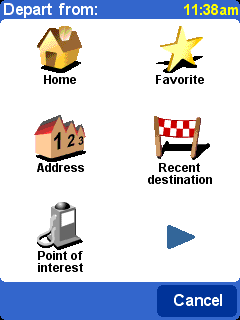
A familiar options screen, but this time
asking where you want to depart from (a question which obviously wasn't
needed when using 'Navigate to...')
Select your departure location in the usual way. You'll then be asked to 'Pick a destination', again with the usual choices. Finally, there's an extra question to answer, since you may be creating this route for someone else. Choose between 'Fastest route', 'Shortest route' (for motor vehicles), 'Avoid highways', 'Walking route' (i.e. the shortest route, ignoring all traffic rules and excluding motorways), 'Bicycle route' (i.e. the shortest route obeying traffic rules but still excluding motorways) or 'Limited speed' (the quickest route for a vehicle of limited top speed, i.e. many road types are equally preferred, apart from highways).
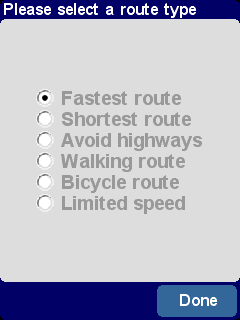
If you'd like this choice every time you
navigate, or if you'd like to change the default setting, see 'Planning preferences'.
Once planned to your preference, the best route is shown on a suitably scaled map. As with 'Navigate to...', you can now select the 'Route' button to explore the detailed route instructions, as detailed in 'View route' below. Finally, select 'Done' to return to the main navigation view.
If you already have a route planned, you can explore it in various ways
by choosing 'View route'
![]() .
.
Choose 'Browse as text'
![]() for a simple
list of the junctions involved and the distances (or times, use the 'Options'
button to change the numbers shown) between them. Selecting an individual
junction from this display or using 'Browse as images'
for a simple
list of the junctions involved and the distances (or times, use the 'Options'
button to change the numbers shown) between them. Selecting an individual
junction from this display or using 'Browse as images'
![]() instead
presents each junction in 3D, with your turn instruction clearly marked. Use
instead
presents each junction in 3D, with your turn instruction clearly marked. Use
![]() and
and
![]() to move
backwards and forwards through your planned route.
to move
backwards and forwards through your planned route.

'Browse as images' is a quick
and powerful way to get a feel for the route you're about to
travel.
Along similar lines, but animated, is 'Show route demo'
![]() , which
simulates your journey at anything up to 500% of 'real time' (chosen using a
simple slider). This works well for journeys within a town or city, but you'll
prefer to use 'Browse as images'
, which
simulates your journey at anything up to 500% of 'real time' (chosen using a
simple slider). This works well for journeys within a town or city, but you'll
prefer to use 'Browse as images'
![]() , mentioned
above, for any journey of significant length. To stop the animation, choose
'View route'
, mentioned
above, for any journey of significant length. To stop the animation, choose
'View route'
![]() and then
'Stop route demo'
and then
'Stop route demo'
![]() .
.
Tip: When browsing a route as images, tap on the center of the screen to switch between 2D and 3D views of each junction (not TomTom MOBILE users).
Finally, you can view your planned route on a traditional top-down map.
Choose 'Browse map of route'
![]() to
overlay the route onto a map that you can zoom and scroll around. See the
chapter 'Maps' for more details of using this screen to
your advantage. Or choose 'Show route summary'
to
overlay the route onto a map that you can zoom and scroll around. See the
chapter 'Maps' for more details of using this screen to
your advantage. Or choose 'Show route summary'
![]() to
display again the graphical overview of your route that was shown when it was
first calculated.
to
display again the graphical overview of your route that was shown when it was
first calculated.
Choose 'Clear route'
![]() if you'd like to
remove the currently planned route from all views. From this moment on, your
position will still be tracked on the map, but no instructions or guidance will
be provided.
if you'd like to
remove the currently planned route from all views. From this moment on, your
position will still be tracked on the map, but no instructions or guidance will
be provided.
Tip: You do not need to clear a route before planning a new one: this happens automatically.
Although 'Navigate to...'
![]() is fine for casual
travel, it may be that you're planning a journey that's more ambitious. You may
even want to save the details of this journey for future use or to pass them on
to other users. Choose 'Itinerary planning'
is fine for casual
travel, it may be that you're planning a journey that's more ambitious. You may
even want to save the details of this journey for future use or to pass them on
to other users. Choose 'Itinerary planning'
![]() to
create a new itinerary or amend an existing one.
to
create a new itinerary or amend an existing one.
An itinerary is essentially just a list of 'waypoints' and 'destinations'. Your best route is calculated, visiting each in turn (in the exact order you specify). In general, you'd add a 'destination' when you wanted countdown information to arrival on the main navigation view, otherwise you'd add a location as a 'waypoint' that simply has to be traveled through (i.e. it's the 'way you want to go').

A typical itinerary, showing both waypoints to be traveled
through and destinations you want to arrive at.
When first started, the itinerary planner will be empty, of course. Use 'Add' to select locations in the normal way, choosing from 'Home', 'Favorite', 'Address', 'Recent destination', and so on. Each location will be added as a waypoint if the previous one was also a waypoint, otherwise it will be added as a destination.
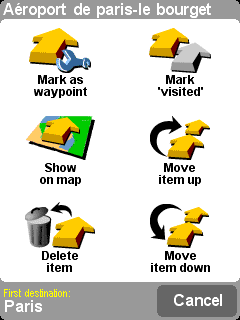
Note that the exact menu options shown here will change
depending on whether the current itinerary entry is a waypoint or destination,
and on whether it has been visited already.
You can manage an individual entry in an itinerary by selecting it,
after which you'll see the waypoint menu (above). Use 'Mark as waypoint'
![]() to change
the entry from a destination to a waypoint, or 'Mark as destination'
to change
the entry from a destination to a waypoint, or 'Mark as destination'
![]() to change
it from a waypoint to a destination.
to change
it from a waypoint to a destination.
Use 'Mark as 'visited''![]() to mark this itinerary entry and all preceding ones as
completed, so that navigation will continue from the next (unvisited) entry.
You can even go back and travel part of an itinerary again by selecting
somewhere you've already been and using 'Mark as 'to visit''
to mark this itinerary entry and all preceding ones as
completed, so that navigation will continue from the next (unvisited) entry.
You can even go back and travel part of an itinerary again by selecting
somewhere you've already been and using 'Mark as 'to visit''
![]() , in which
case this and all following itinerary entries will be included in navigation
again.
, in which
case this and all following itinerary entries will be included in navigation
again.
'Delete item', 'Move item up' and 'Move item down' are self-explanatory.
If you want to save your itinerary for re-use in the future, or if you
want to load a previous itinerary, choose
'Options', using 'Save
itinerary'
![]() or 'Load
itinerary'
or 'Load
itinerary'
![]() respectively. When saving, you can enter a name for the itinerary using the
standard on-screen keyboard (by default it takes its name from your last
destination).
respectively. When saving, you can enter a name for the itinerary using the
standard on-screen keyboard (by default it takes its name from your last
destination).
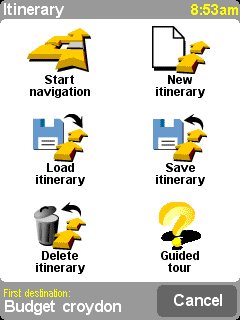
By saving your itineraries, you can re-use them at a later date
without having to re-enter any of the locations. Use this screen to save, load
or delete an itinerary, or to start a new one.
Select 'Start navigation'
![]() on the
'Options' menu to start
navigating.
on the
'Options' menu to start
navigating.
Our optional TomTom PLUS service can give you real time information on traffic congestion, helping you route around it. In addition, there is current weather information for any location on your map, plus special downloads, including detailed city maps, extra voice files and extra POI databases.
To use TomTom PLUS, you need:
(If you already pick up email or browse the Internet on your phone, then it's probably already GPRS-ready; if you're not sure, ask your network provider.)
You'll be taken through the very brief sign-up process when you try to use any of TomTom PLUS's services for the first time. Enter your email address as your TomTom PLUS user name and the TomTom product code as your password (without any spaces). That's it! You can now use any of the extra services.

Enter your e-mail address.

For free trial enter ‘PLUS’ or your own password.
You'll now receive an email with your user name and password, giving you access to the member area of the TomTom PLUS web site. You can then go to www.tomtom.com to purchase subscriptions and find out about offers and free services that are available for your product.
Tip: TomTom Traffic has been designed to retrieve traffic information over a GPRS connection. Do not use it with a GSM data connection, as this can lead to substantial communication costs.
Note: Due to its dynamic nature, traffic information can by definition never represent the full, current traffic situation. There are locations for which information is not available, and some delays might not be detected on time. Quality, coverage and reporting times will differ from one region to the other.
Choose 'TomTom Traffic'
![]() and then
'Enable traffic'
and then
'Enable traffic'
![]() to switch
on the main TomTom Traffic service and the other related route planning and map
display functions. If there is traffic information available for your area,
TomTom traffic will stay enabled until you choose 'Disable traffic'
to switch
on the main TomTom Traffic service and the other related route planning and map
display functions. If there is traffic information available for your area,
TomTom traffic will stay enabled until you choose 'Disable traffic'
![]() later
on.
later
on.

Select 'Update traffic info'
![]() to
download the latest traffic information for your area (if available) from the
TomTom Traffic Internet server, using your phone's GPRS data connection. Back
in the main navigation view, you'll notice a new traffic 'route bar' on the
right hand side of the screen. In the top right corner is a special animation,
which TomTom Traffic uses to show you its current status:
to
download the latest traffic information for your area (if available) from the
TomTom Traffic Internet server, using your phone's GPRS data connection. Back
in the main navigation view, you'll notice a new traffic 'route bar' on the
right hand side of the screen. In the top right corner is a special animation,
which TomTom Traffic uses to show you its current status:

| Traffic information is being updated | |
| Traffic information was updated less than 10 minutes ago | |
| Traffic information was updated less than 20 minutes ago | |
| Traffic information was updated less than 30 minutes ago | |
| Traffic information was updated less than 40 minutes ago | |
| Traffic information was updated more than 40 minutes ago | |
| If the color of the indicator turns yellow, this means there is more up-to-date traffic information available on the server for you to download | |
|
The connection to the TomTom Traffic server
failed. Try choosing 'Update traffic info' again. If it still fails,
it's probably for one of the following reasons: GPRS settings incorrect. Ask your network provider for help with your phone's settings. The account is registered for another device. Select 'New device' in the 'My Traffic' section of 'My TomTom' on www.tomtom.com and try again. (You can only use your Traffic account on one device at a time.) Your subscription has expired. In the Traffic section of 'My TomTom' you can look up details of your traffic account and extend your subscription. |
If you have a route already planned, you'll also be able to use the route bar, beneath the TomTom Traffic status animation. Imagine the bar, from bottom to top, represents the remainder of your journey. Traffic delays are then shown at the appropriate relative points along the route bar, so that you can see what obstacles await you. TomTom Traffic uses a variety of different delay icons, as shown below:
|
|
Traffic delay |
|
Road works |
|
Avoided traffic delay |
|
|
Accident |
|
One or more lanes closed |
|
Fog |
|
|
Traffic jam |
|
Road closed |
|
Rain |
|
|
Wind/Storm |
|
Snow/Ice/Hail |
You'll see these same icons used in more detail within the main
'TomTom Traffic'
![]() system. Use
the menu option 'Show traffic info'
system. Use
the menu option 'Show traffic info'
![]() to
display an overview of all delays on your planned route. In addition to the
icons above, the overview also shows three different road patterns:
to
display an overview of all delays on your planned route. In addition to the
icons above, the overview also shows three different road patterns:
![]() (slow traffic),
(slow traffic),
![]() (stopped
traffic) and
(stopped
traffic) and ![]() (road works).
(road works).

A typical TomTom Traffic overview. Choose
'Update' to get the latest
traffic information from the TomTom server.
Selecting 'Replan'
will calculate a new best route for you, automatically taking into account the
delays and their severity. For clarity, delays on the overview are
shown as simple red circles. If you'd like more details, you can use (![]() and)
and)
![]() to step
through the delays, one by one.
to step
through the delays, one by one.

The number (e.g. 1st of 17) in the title bar indicates which
delay you're viewing along your route.
Note: A planned route may still take you through a traffic jam if this is still considered to be the fastest way to your destination (i.e. faster than less congested alternatives).
Tip: As an alternative to using 'Replan' on the TomTom Traffic overview screen, you can use 'Minimize traffic delays' on the 'Find alternative' menu.
Instead of being restricted to the scope of a particular route, you can
also choose 'Browse map'
![]() to view
all traffic delays applicable to your local map. As usual, you can scroll
around and zoom in and out, to see any area in detail.
to view
all traffic delays applicable to your local map. As usual, you can scroll
around and zoom in and out, to see any area in detail.

As you zoom further into the map, TomTom Traffic
will change delay indicators into detailed icons, giving you more
information. If you select an individual delay, full details will be shown
in the same way as within Show traffic info above.
Depending on your GPRS rate with your network provider, you may want to
use 'Change Traffic preferences'
![]() to
automatically keep TomTom Traffic (and your route) updated while you're on the
road. For full automation, tick 'Automatically update traffic info while on
route' and 'Automatically optimize the route after every update'.
You'll probably also want to tick 'Beep when route traffic situation
changes', to receive an audio warning when the update takes place and a new
traffic situation is reported.
to
automatically keep TomTom Traffic (and your route) updated while you're on the
road. For full automation, tick 'Automatically update traffic info while on
route' and 'Automatically optimize the route after every update'.
You'll probably also want to tick 'Beep when route traffic situation
changes', to receive an audio warning when the update takes place and a new
traffic situation is reported.
By going to the Traffic section of 'My TomTom' (www.tomtom.com), you will be able to:
Choose the main menu option 'TomTom Weather'
![]() to get information about the current weather at any location, selected using the usual
destination options. Using your configured wireless GPRS Internet connection,
TomTom looks up weather information from thousands of weather stations around
the world (located at airports), presenting the most suitable to the selected
location.
to get information about the current weather at any location, selected using the usual
destination options. Using your configured wireless GPRS Internet connection,
TomTom looks up weather information from thousands of weather stations around
the world (located at airports), presenting the most suitable to the selected
location.


The weather information available includes:
In addition to the two dynamic services above, you can also download many extras, such as new sets of Points of Interest, new voices, etc. The items that appear for download could comprise some extra, free items (available for everyone), as well as the items you've already purchased (so you can reload them if needed) and a limited number of 'premium' items (during an initial period). The list of items that appears on your device will vary according to the number of free premium items you have ‘used up’ during your initial period. You can purchase more premium items at any time from www.tomtom.com.
Start by choosing 'Download extras'
![]() from the
main menu.
from the
main menu.
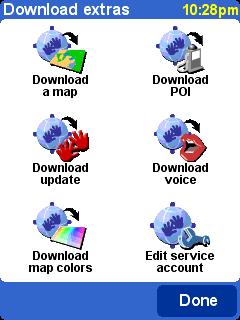
Choose 'Download a map'
![]() to grab a map
of a city that didn't already come with your TomTom system. For example, if
you're planning a weekend or city trip, you can download the city map for your
destination. Follow the prompts, choosing a country and then searching for the
city you want.
to grab a map
of a city that didn't already come with your TomTom system. For example, if
you're planning a weekend or city trip, you can download the city map for your
destination. Follow the prompts, choosing a country and then searching for the
city you want.

Some of the matches may be marked as '[big]' or '[free]',
indicating that they're either too large to comfortably download over GPRS or
that they're free to all (so you don't have to worry about downloading them
within your initial period).
Tip: City maps can be large in size. For bigger cities we advise you NOT to download the maps directly to your device since the costs for the GPRS data session can be significant. For these larger maps, it’s better to download them first on your desktop computer and then transfer them using your usual connection.
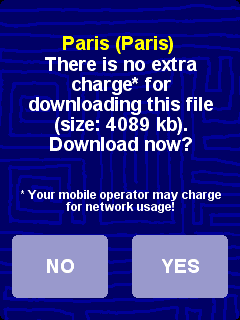
Here we're about to download a city map. Note that you will be
warned if there’s not enough space on your device to download the area or
city chosen.
To start using your newly downloaded map, use 'Manage maps'.
Downloading a new set of Points Of Interest is very similar. Use
'Download POI'
![]() . Only sets
that are free, part of your purchased system or available under an initial
period will be listed.
. Only sets
that are free, part of your purchased system or available under an initial
period will be listed.
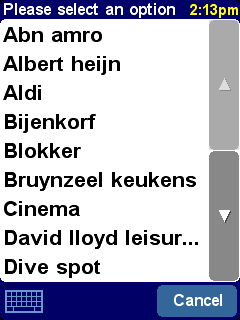
Once downloaded, you can navigate to POIs in the new sets in the
usual way, or opt to display them on your maps using 'Show
POI' and 'Manage POI'.
Your TomTom system comes with a number of voice options you can choose from to guide you during navigation. With TomTom PLUS you can download new voices to find one that suits you better (or just for fun). The digital voice sample files are relatively larger in size, so you shouldn't normally download them directly to your device using GPRS. Use your desktop's fast Internet connection, logging in to www.tomtom.com, then transfer the voice files using your USB cable instead. Once downloaded, use 'Change voice' to start using the voice samples in navigation.
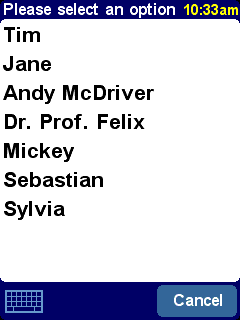
As before, only free voices or premium voices that you have
already purchased or that are part of your bundle will be
listed.
Your TomTom system comes with a number of different map and navigation
color schemes, to cater for personal preference, regional differences and
night/day use. Use 'Download map colors'
![]() to see
the extra schemes available on TomTom PLUS.
to see
the extra schemes available on TomTom PLUS.
Once downloaded, use 'Change map colors' to browse to and select a new color scheme.
Choose 'Download update'
![]() to check
for application updates for your TomTom system. If one is available, note that
it may have to be installed via your desktop computer.
to check
for application updates for your TomTom system. If one is available, note that
it may have to be installed via your desktop computer.
You can use 'Edit service account'
![]() to
enter updated TomTom PLUS username and password details on your device, perhaps
because you changed them to something more memorable on
www.tomtom.com.
to
enter updated TomTom PLUS username and password details on your device, perhaps
because you changed them to something more memorable on
www.tomtom.com.
Note: TomTom PLUS services vary by country and are updated regularly. Please visit www.tomtom.com frequently to find out about new premium content and bundle offers.
Note: The use of TomTom PLUS services does not take into account the cost of GPRS data calls from your device. Please check your network operator for cost details.
The digital maps form the basis of everything your TomTom product can do and many functions make use of the map browser. This chapter explains how to move around in the browser and how to use it to set up destinations and search for things.
Choose 'Browse map'
![]() now, to get started in the map browser. The map view is oriented in the same
way as in a paper map, i.e. with north 'upwards', and shows the usual cities,
towns, major roads, streets, railway lines, rivers and lakes. Unlike a paper
map, you can zoom in and out and vary the amount of detail shown. You can also
overlay categories of Points Of Interest, Traffic information (if subscribed)
and personal elements such as favorite locations and departure/destination
points.
now, to get started in the map browser. The map view is oriented in the same
way as in a paper map, i.e. with north 'upwards', and shows the usual cities,
towns, major roads, streets, railway lines, rivers and lakes. Unlike a paper
map, you can zoom in and out and vary the amount of detail shown. You can also
overlay categories of Points Of Interest, Traffic information (if subscribed)
and personal elements such as favorite locations and departure/destination
points.
 |
The main elements of the map browser are: |
Note: The appearance of the map and its associated controls will differ slightly when using live Traffic information (dimmed main colors, highlighted traffic delays). In addition, TomTom GO remote control or TomTom MOBILE users will see just two buttons, 'Options' and 'Done'. In these cases, choosing 'Options' brings up extra controls, including 'Use cursor...' and 'Find'.
You can scroll around a map by dragging it with your finger (TomTom GO
users), stylus (NAVIGATOR users) or by using your NAVIGATOR key (TomTom MOBILE
users). Maps will usually be scaled for you, perhaps to encompass a
recently-calculated route or to show details of a particular junction, but you
can adjust the scale yourself if needed. If the zoom bar is showing, simply
drag its handle
![]() up and down slowly. The map will be continuously zoomed in (when
sliding down) and out (when sliding up) around the current cursor position. If
the zoom bar is absent (TomTom MOBILE users or when TomTom GO is used with the
optional remote control), press 'OK' to access the zoom functions.
up and down slowly. The map will be continuously zoomed in (when
sliding down) and out (when sliding up) around the current cursor position. If
the zoom bar is absent (TomTom MOBILE users or when TomTom GO is used with the
optional remote control), press 'OK' to access the zoom functions.
Tip: Only a 'blocky' preview map is shown while you're changing the zoom level. The moment you lift your finger, the map is drawn properly in full detail.
The cursor ![]() is the most valuable tool in the map browser. Select
any spot on the map to place the cursor there. You can then do things with the
current cursor position by using the cursor function
is the most valuable tool in the map browser. Select
any spot on the map to place the cursor there. You can then do things with the
current cursor position by using the cursor function
![]() .
.
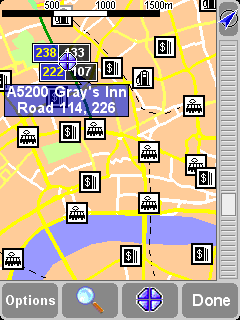
After positioning the cursor, the nearest road segment is
automatically highlighted in green and labelled, together with start and finish
house numbers on each side of the road segment (if relevant).
Choose 'Navigate there'
![]() to plan a route
from your current GPS position to the cursor position.
to plan a route
from your current GPS position to the cursor position.
Choose 'Center on map'
![]() to make the
cursor position the new map center, i.e. with your chosen spot in the center of
the screen.
to make the
cursor position the new map center, i.e. with your chosen spot in the center of
the screen.
Choose 'Find nearby POI'
![]() to find the Point
Of Interest nearest to the cursor position. As usual, icons are shown for the
five categories that you've used most recently, use
to find the Point
Of Interest nearest to the cursor position. As usual, icons are shown for the
five categories that you've used most recently, use
![]() to bring up a list of all categories that are available. Within a category, use
to bring up a list of all categories that are available. Within a category, use
![]() and
and
![]() to scroll through the list of all Points Of Interest, sorted
according to their distance from your cursor position. Choose the one you want,
to display it (or as near as it's possible to get to it using standard roads)
in the center of the map screen.
to scroll through the list of all Points Of Interest, sorted
according to their distance from your cursor position. Choose the one you want,
to display it (or as near as it's possible to get to it using standard roads)
in the center of the map screen.
Choose 'Add as POI'
![]() to add the cursor
position as a new POI item in one of your own categories. For example, adding a
new company site to a 'Your offices' category. If you haven't yet created any
categories, you'll be offered the chance to create one now.
to add the cursor
position as a new POI item in one of your own categories. For example, adding a
new company site to a 'Your offices' category. If you haven't yet created any
categories, you'll be offered the chance to create one now.
Note: You can't add extra Points Of Interest to the built-in POI categories.
Choose 'Travel via...'
![]() to create a
route that includes the cursor position.
to create a
route that includes the cursor position.
Finally, and perhaps most usefully of all, tap on 'Add as
favorite' ![]() to
set the current cursor position as a favorite location. This can be invaluable
for locations which don't have known or recognized addresses.
to
set the current cursor position as a favorite location. This can be invaluable
for locations which don't have known or recognized addresses.
Use the
![]() control
('Find') to scroll the map quickly to any specific location (Address,
Recent destination, POI, etc.) In addition to centering the map on your chosen
location, the zoom level is also reset to show the location in appropriately
high detail.
control
('Find') to scroll the map quickly to any specific location (Address,
Recent destination, POI, etc.) In addition to centering the map on your chosen
location, the zoom level is also reset to show the location in appropriately
high detail.
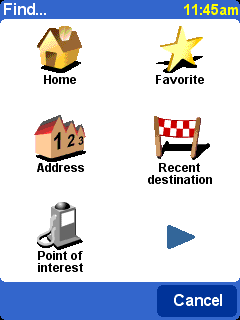
You'll be familiar with the types of location that
can be found. Note that the 'Point of interest' option finds and sorts
items by distance from your current GPS position, not by distance from the
center of the map or from the cursor position. To find Points Of Interest
sorted by distance from the cursor position, see 'Find nearby POI' in
Cursor functions, above.
Use the 'Options' button to customize the level of detail shown on the map. (If using TomTom MOBILE or the optional GO remote control, 'Options' is also your way into cursor and find functions, with 'Change preferences' giving you the options below.)
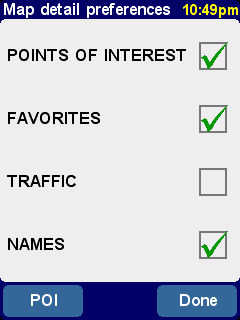
The choices made here will apply to all future
displays of the map view.
Clearing the 'Names' check-box (it's ticked by default) will stop the display of relevant town and district names. Ticking 'Favorites' will pop up a yellow star for each favorite location (only on the map view). If TomTom Traffic is enabled, note you can tick 'Traffic' to show current traffic information on the map (whose appearance will be altered to highlight traffic delays).
You can turn on (or off) the display of 'Points Of Interest' on the map view by ticking its check box. Which Points Of Interest are displayed depends on the categories you have chosen to show. You can make this choice now, by selecting the 'POI' button, or later, using 'Manage POI' in Preferences.
Depending on which application package you purchased, there may be more than one map database available. If so, you can use 'Manage maps' in Preferences to switch maps or even download a new one.
You can change much of the look and feel of your TomTom
system to your own liking by using 'Preferences'
![]() . To see all the
options described in this chapter, use
. To see all the
options described in this chapter, use
![]() to cycle
through the different pages.
to cycle
through the different pages.
Note: The icons shown for some preferences will change, depending on the state the preference is currently in. For example, choosing 'Turn off sound'disables the voice instructions. Once disabled, the option and icon change to 'Turn on sound'
, reflecting the action to take when next selected.
Bright colors are normally used, with a lot of contrast,
so that you can see the map clearly even in bright sunlight. When it is dark
outside, you may want to 'Use night colors'
![]() . The navigation
view will then be displayed (by default) using dark and subdued colors that
will not interfere with your night vision. In addition, the preference is
changed to 'Use day colors'
. The navigation
view will then be displayed (by default) using dark and subdued colors that
will not interfere with your night vision. In addition, the preference is
changed to 'Use day colors'
![]() ; select this to
revert to the original color scheme.
; select this to
revert to the original color scheme.
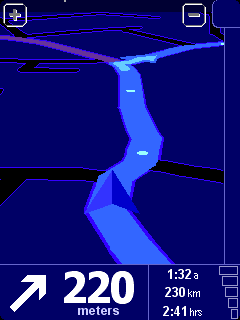
These are the default night colors, but you can select any
color scheme you like, for either day or night use, by using the preference
'Change map colors'.
The main 3D navigation view, showing maps, routes and
Points Of Interest from the perspective of the vehicle driver, can be switched
to a more conventional view. Choose 'Turn off 3D display'
![]() to revert to an
overhead 'plan' map, albeit one which is constantly rotated to keep your
current direction of travel pointing 'up' the screen. Choose 'Turn on 3D
display'
to revert to an
overhead 'plan' map, albeit one which is constantly rotated to keep your
current direction of travel pointing 'up' the screen. Choose 'Turn on 3D
display' ![]() to
return to the original view.
to
return to the original view.
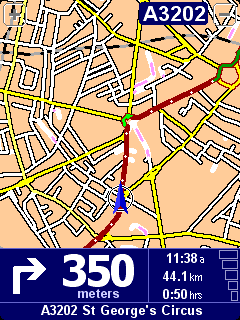
In addition to the alternative 'plan' view shown here, there's
also a simple 'schematic' view.
Above a specified speed, for safety reasons, the main map
view can be replaced by a 'schematic' view, focussed on the next driving
instruction. You can choose to use this feature by choosing 'Turn off map
display' ![]() .
Select 'Above certain speed' to specify a cut-off speed, or 'Always' to have
the schematic view shown at all speeds. Choose 'Turn on map display'
.
Select 'Above certain speed' to specify a cut-off speed, or 'Always' to have
the schematic view shown at all speeds. Choose 'Turn on map display'
![]() to always show
the map again.
to always show
the map again.
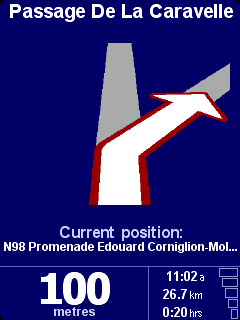
Note the way the distance to the upcoming
turn information is shown in the bottom-left of the screen.
You'll find it useful to just show specific categories of
Points Of Interest (POI) on the navigation and map views, using the preference
' 'Manage POI'. Once you've spent time carefully
browsing through the categories and choosing the ones you need, you can hide
all of them from the main navigation view in one stroke with 'Hide POI'
![]() or show your
preferred set again with 'Show POI'
or show your
preferred set again with 'Show POI'
![]() .
.
You can turn off the voice that gives navigation
instructions by choosing 'Turn off sound'
![]() . This is
indicated during navigation by the
. This is
indicated during navigation by the
![]() icon in the
lower left-hand corner of the screen. To turn the voice instructions back on
again, select 'Turn on sound'
icon in the
lower left-hand corner of the screen. To turn the voice instructions back on
again, select 'Turn on sound'
![]() .
.
To change the volume of the spoken instructions, use 'Volume preferences'. To select another voice (i.e. gender and/or language), use the preference 'Switch language'.
You can change the volume of the voice instructions by
using 'Volume preferences'
![]() , with its
sliding scale to set the required volume in increments of 5%. The 'Test'
function is a good way to get the volume right before starting your
journey.
, with its
sliding scale to set the required volume in increments of 5%. The 'Test'
function is a good way to get the volume right before starting your
journey.
You may also find it helpful to use 'Link volume to car speed', so that the voice instructions get louder as road noise increases and are at their quietest when you are stationary.
In time, you may want to use 'Manage favorites'
![]() to delete any
favorite locations that are no longer needed. You can also rename them, if you
wish. Use
to delete any
favorite locations that are no longer needed. You can also rename them, if you
wish. Use
![]() and
and
![]() to scroll up and down the list and pick the one you want to change
or delete.
to scroll up and down the list and pick the one you want to change
or delete.
Note: If you haven't added any favorite locations yet, the 'Manage favorites' icon will be greyed out and unavailable.
Tip: The way to change a favorite's location is to delete the current instance and create a new one at the correct location. See Favorite locations.
You can set or change your 'Home' location at any time by
using 'Change Home location'
![]() . You will then
be able to select this later as a departure or destination point.
. You will then
be able to select this later as a departure or destination point.
Tip: 'Home' doesn't necessarily have to be your physical home. Set it to the location that is most central in your travels, for example: your office.
If you have maps of another country or area installed, the
preference 'Manage maps'
![]() will be
enabled. Choose 'Switch map'
will be
enabled. Choose 'Switch map'
![]() to switch to
another map that's already available. The map that you are currently using is
highlighted in yellow, select the map you wish to use next.
to switch to
another map that's already available. The map that you are currently using is
highlighted in yellow, select the map you wish to use next.
Tip: If you want to switch to a map on a different memory card, just eject the current one and put the new card in.
Choose 'Download a map'
![]() to buy extra
maps directly from TomTom using your optional GPRS phone connection. Simply
follow the prompts to choose the area or city that you'd like to buy. Be aware
that your network provider will charge your download at your usual GPRS rate
and that TomTom are not responsible for any extra charges you may incur.
to buy extra
maps directly from TomTom using your optional GPRS phone connection. Simply
follow the prompts to choose the area or city that you'd like to buy. Be aware
that your network provider will charge your download at your usual GPRS rate
and that TomTom are not responsible for any extra charges you may incur.
The preference 'Manage POI'
![]() is the control
panel for Points Of Interest and their categories. It's easy to create new
categories of your own (e.g. 'Offices', 'Garden centers', 'Customer X') and
populate them with relevant Points Of Interest that can be navigated to or
added to an itinerary in seconds.
is the control
panel for Points Of Interest and their categories. It's easy to create new
categories of your own (e.g. 'Offices', 'Garden centers', 'Customer X') and
populate them with relevant Points Of Interest that can be navigated to or
added to an itinerary in seconds.
You can add new Points Of Interest to categories that
you've created yourself. First, use 'Add POI Category'
![]() and then
choose 'Add POI'
and then
choose 'Add POI'
![]() . You'll then be
asked to pick a category (and prompted to add one if you haven't made any yet),
then pick a location in the usual way.
. You'll then be
asked to pick a category (and prompted to add one if you haven't made any yet),
then pick a location in the usual way.
In both the main navigation view and on all map views, you
can choose which Points Of Interest categories are shown by selecting
'Enable/Disable POI'
![]() . Just tick the
ones you want to show.
. Just tick the
ones you want to show.
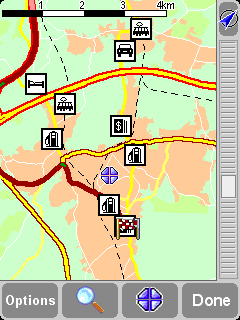
Locations in your chosen categories are
plotted on the map (and navigation view), each represented by its own
icon.
Tip: You can choose whether or not to show Points Of Interest at all, using 'Hide POI/Show POI' for the navigation view or 'Map options' for the map browser. In this way, you can keep your chosen Points Of Interest categories permanently ticked.
It's easy to manage your custom Points Of Interest, using
'Delete POI'
![]() and 'Delete
POI category'
and 'Delete
POI category'
![]() , as
needed.
, as
needed.
Additionally, you can request audio and visual warning that
a POI from a specific category is coming up. For example, you might be on the
lookout for a gas station or hotel. To set up a warning (you
can have as many as you like), use 'Warn when near POI'
![]() . You'll
then be asked to choose a category (any that are already set up for warning
will be shown at the top of the list) and choose a 'Warn when closer than'
distance, as shown below.
. You'll
then be asked to choose a category (any that are already set up for warning
will be shown at the top of the list) and choose a 'Warn when closer than'
distance, as shown below.
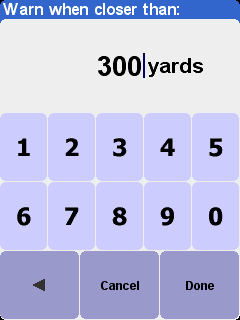
250 yards is a good default value, but may need to
be larger or smaller depending on whether you want warning of something huge
(e.g. an airport or tourist attraction) or something small (e.g. scenic view).
You'll probably want different audible warnings for each
Point of interest category. Use
![]() and
and
![]() to browse the
different warning sounds available, choosing 'Select' for the most suitable.
Finally, tick 'Warn only if POI is on route', if needed.
to browse the
different warning sounds available, choosing 'Select' for the most suitable.
Finally, tick 'Warn only if POI is on route', if needed.
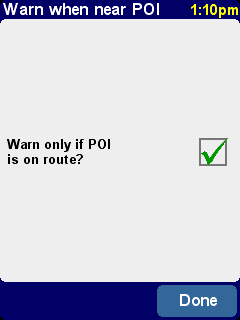
You'd typically only tick this for
items that have to be on the roadside and in your direction of travel. . For example, gas stations which are on your route, rather than accessed from the opposite direction.
Use 'Status bar preferences'
![]() to
customize the information shown at the bottom of the navigation view. For
example, you might prefer to know the arrival time rather than the remaining
time. In general, the fewer items you tick, the larger and clearer the layout of
the status bar will be.
to
customize the information shown at the bottom of the navigation view. For
example, you might prefer to know the arrival time rather than the remaining
time. In general, the fewer items you tick, the larger and clearer the layout of
the status bar will be.
If the way you're positioning your TomTom system requires it, you can
rotate the display with the preference 'Rotate screen'
![]() . Each
time you use this, the display will be rotated further, until it's back to its
original orientation.
. Each
time you use this, the display will be rotated further, until it's back to its
original orientation.
Select 'Change map colors'
![]() to choose
between the alternative color schemes that are available for the maps used in
your TomTom system (several of which are most suitable for use at night). Use
to choose
between the alternative color schemes that are available for the maps used in
your TomTom system (several of which are most suitable for use at night). Use
![]() and
and
![]() to scroll
through the different 'day color schemes', using 'Select' when you're
happy with the scheme shown. Repeat the process for the different 'night color
schemes'.
to scroll
through the different 'day color schemes', using 'Select' when you're
happy with the scheme shown. Repeat the process for the different 'night color
schemes'.
To switch between day and night colors in normal use, see 'Use night colors'.
Select 'Planning preferences'
![]() to choose
how routes should be calculated. If your mode of transport is often different,
you may want to select 'Ask me when I plan', otherwise select one of the other
options. 'Walking routes', 'Bicycle routes' and 'Limited speed routes' have
been detailed already, in 'Advanced
planning'.
to choose
how routes should be calculated. If your mode of transport is often different,
you may want to select 'Ask me when I plan', otherwise select one of the other
options. 'Walking routes', 'Bicycle routes' and 'Limited speed routes' have
been detailed already, in 'Advanced
planning'.
'Toll charge preferences'
![]() give you
a chance to specify what should happen in the event of your TomTom system
considering a toll road in its calculations. Select 'Always avoid toll
roads' to automatically exclude these from future routes, select 'Never
avoid toll roads' to allow a best route to be calculated regardless of any
toll charges. Otherwise, simply leave this preference at its default of 'Ask
me when it happens'.
give you
a chance to specify what should happen in the event of your TomTom system
considering a toll road in its calculations. Select 'Always avoid toll
roads' to automatically exclude these from future routes, select 'Never
avoid toll roads' to allow a best route to be calculated regardless of any
toll charges. Otherwise, simply leave this preference at its default of 'Ask
me when it happens'.
If you'd like a compass shown on the navigation view, use 'Compass
preferences'
![]() to choose a
compass type.
to choose a
compass type.
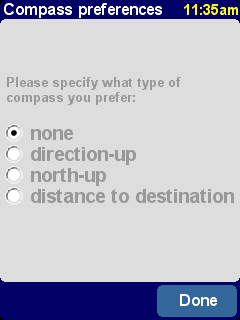
'Direction-up' acts like a real compass (as if mounted on
your dashboard), with the arrow always pointing north. 'North-up' keeps
the compass dial static, with the arrow indicating your current direction of
travel. 'Distance to destination', as it sounds, simply indicates the
relative direction and distance of your destination.
You can change the voice used for route instructions at any
time by using the preference 'Change voice'
![]() . Use
. Use
![]() and
and
![]() to scroll
through the different voices and languages, choosing 'Test' to hear a
sample in each one. Use 'Select' when you're happy with the voice that's
indicated.
to scroll
through the different voices and languages, choosing 'Test' to hear a
sample in each one. Use 'Select' when you're happy with the voice that's
indicated.
Note: Most languages feature more than one possible voice. To change the volume of the voice instructions, see 'Volume preferences'.
You can change the language used to display all on-screen
text, instructions and menu options with 'Switch language'
![]() . Just choose the
one you want.
. Just choose the
one you want.
You can change your preferred units of measurement at any
time with the preference 'Set units'
![]() . Three questions
are then displayed, one a time, for distances, times and longitude/latitude.
Simply choose the formats you prefer for each unit and select 'Done' for
each one.
. Three questions
are then displayed, one a time, for distances, times and longitude/latitude.
Simply choose the formats you prefer for each unit and select 'Done' for
each one.
If you are left-handed, you will probably want to use
'Operate left-handed'
![]() to place scroll
controls, the map zoom control and 'Done' and 'Cancel' buttons on the left side
of the screen where possible. You will then be able to tap on them more
conveniently without your left hand obscuring the screen. To revert to the
original button placement, choose the preference 'Operate right-handed'
to place scroll
controls, the map zoom control and 'Done' and 'Cancel' buttons on the left side
of the screen where possible. You will then be able to tap on them more
conveniently without your left hand obscuring the screen. To revert to the
original button placement, choose the preference 'Operate right-handed'
![]()
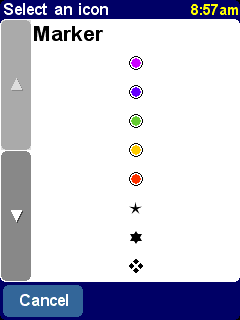
Operating your TomTom system
left-handed!
Choose 'Keyboard preferences'
![]() to choose the
size (large or small) of the on-screen keyboard for the entry of text and
numbers (the smaller version leaves more room for items in scrolling lists),
and to choose between alphabetic (ABCD), typewriter (QWERTY) and French
(AZERTY) layouts.
to choose the
size (large or small) of the on-screen keyboard for the entry of text and
numbers (the smaller version leaves more room for items in scrolling lists),
and to choose between alphabetic (ABCD), typewriter (QWERTY) and French
(AZERTY) layouts.
You can adjust the way road names are displayed on the maps
with 'Name preferences'
![]() . There are four
check boxes shown:
. There are four
check boxes shown:
Hopefully you'll find the occasional tip a help (each one is only shown
once, in a relevant place), but if you really don't like them then they can be turned off altogether with 'Hide tips'
![]() or opt to start
showing them again with 'Show tips'
or opt to start
showing them again with 'Show tips'
![]()
Use 'Show version'
![]() to find out
exact version information for your TomTom system. Select 'Copyright' to
read the appropriate copyright listing.
to find out
exact version information for your TomTom system. Select 'Copyright' to
read the appropriate copyright listing.
Here are some of the questions you may need to ask. For more questions and answers, see www.tomtom.com
Why is the navigation view now in black and white? Why won't
'Navigate to...' work?
If the GPS receiver loses reception from the
orbiting satellites, usually due to surrounding tall buildings, the map display
is switched into monochrome, to warn you that the information shown may not be
accurate at that moment. As soon as reception is regained, the display will
automatically switch back to color.
How do I get support?
Visit www.tomtom.com for
technical support and contact information. Our preferred means of communication
is by email.
How can I find out my TomTom system's software version and serial
number?
On any route summary screen, the software version number is
shown in a box beneath the GPS satellite status icon. If you tap the box,
you'll see more details of your system's configuration and the current map. You
can also display this information by using the Preference 'Show version'
![]() .
.
Why should I register on the TomTom web site (updates, support,
etc)?
Registering your product gives you access to all the latest news
about your TomTom system and will help us to supply you with the best possible
support.
Data Source © 2005 Tele Atlas N.V. Based upon:
Topografische ondergrond Copyright © dienst voor het kadaster en de openbare registers, Apeldoorn 2005.
© Ordnance Survey of Northern Ireland.
© IGN France.
© Swisstopo.
© BEV, GZ 1368/2003.
© Geonext/DeAgostini.
© Norwegian Mapping Authority, Public Roads Administration / © Mapsolutions. © DAV.
This product includes mapping data licensed from Ordnance Survey with the permission of the Controller of Her Majesty’s Stationery Office. © Crown copyright and/or database right 20nn. All rights reserved. Licence number 10002692.
© 2005 TomTom BV, The Netherlands. Patents pending. All rights reserved.
TomTom and the TomTom logo are registered trademarks of TomTom B.V. The Netherlands. All other trademarks are the property of their respective owners.
The use of TomTom products is governed by a license agreement which is included in this package and/or the products. This license contains a limited warranty and limitation of liability. You can review the license conditions at www.tomtom.com.
The information in this document is subject to change without notice. TomTom B.V. shall not be liable for technical or editorial errors or omissions contained herein; not for incidental or consequential damages resulting from the performance or use of this material. This document contains information protected by copyright. No part of this document may be photocopied or reproduced in any form without prior written consent from TomTom B.V.